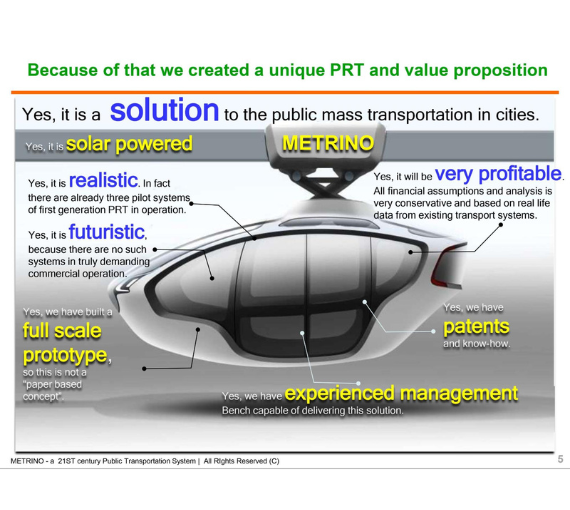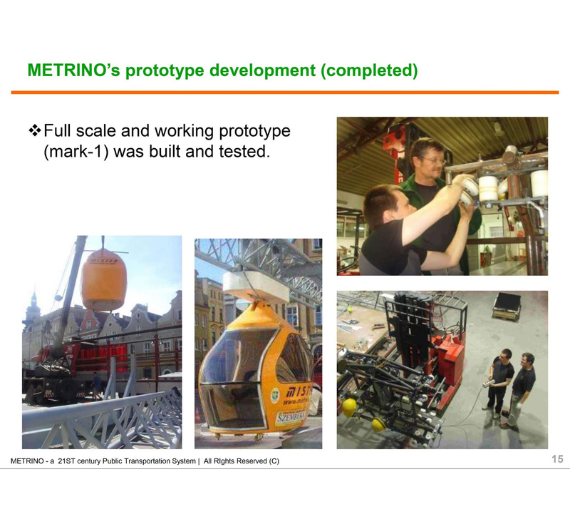
PRT Public Rapid Transport System






Explore More Ropeway Systems: Ziplines | Self Propelled Ropeway Systems
COMPARATIVE OVERVIEWS OF PUBLIC TRANSPORT SYSTEMS AND METRINO PRT
This comparison does not account for the system features like comfort and operations economics. All current public transport systems must be subsidized, while METRINO will be very profitable, even at current public transport fares.
PRT:
The very high economic cost to other road users, if PRT Right Of Way is taken from the existing road space, reduces the available number of traffic lanes. It is a hidden cost, not accounted for properly.This type of PRT was caused in Delhi a few years ago by court action because the social and economic benefits were minimal while the system caused paralysis of traffic along PRT routes and has been subsequently dismantled. Advanced rapid transit solutions for sustainable urban living. Cities thrive with a well-designed public rapid transport system.
Alternatively, if new road space is created, then it is very high capital expenditure, like in some other countries, which also do not properly analyze the cost/benefit ratio of such segregated PRT traffic lanes.
A number of PRT corridors I usually very limited and not providing any substantial improvement in the overall transit capacity, while buses still waste time at intersections, unless the additional and substantial expenditure is spent on priority signaling or multi-level intersection. Eco-friendly mass rapid transit systems are the future of mobility. Sustainable city travel with the mass rapid transit system in India.
Overall, PRT solutions are not economical and they do not provide major benefits, except along a very limited number and length of routes.
Monorail:
Very high capital cost, similar to metro or heavy rail, long planning, consent, and development process. As for PRT, even more, limited coverage of the city.Metro:
There is little difference between the metro and the monorail. One can say that Monorail is a smaller version of the metro. So metro has an even higher capital cost, especially in the areas where it must be located underground. Long planning, consent, and development process.METRINO ENERGY REQUIREMENTS / CONSIDERATIONS -
METRINO ™ vehicles (Pods) are supplied with electricity from traction laid within the guideways and connected to the city power grid or external power generation facilities. This will be augmented by backup diesel generators. Standard electric motors power the drive wheels of each Pod, as in trains or electric cars. Special onboard electronic systems will ensure the safe and continuous operation of drive units in vehicles, which are independent of each other. Urban growth is incomplete without a robust rapid transit system. Adopt rapid transit solutions for reliable daily commutes.
Metrino uses very little energy. It can be grid independent and can generate its own electricity from photovoltaic and wind sources located on top of guideways, pods, and stops. The era of photovoltaic cell technology, a method of producing electricity from light, is the future of energy self-sufficiency for Metrino. It reduces the reliance on locally generated power while providing an additional ecological benefit. Access efficient routes with the public rapid transport system. Revolutionize travel with an advanced mass rapid transit system.
In the unlikely case of full power failure, Metrino pods will have enough energy in their own backup onboard battery to drive themselves to ensure that passengers are dropped off at their destination. The maximum power that Metrino will require is 5 MW per each 10 km of network, (average usage being approx. 3 MW). This is much less than any other public transit system would use for transporting a similar number of passengers over the same distance.
Solar power is already less expensive than fossil fuel-generated power “grid power”. Solar power costs approx INR rs. 5 per kWh, Metrino’s economic analysis is based on the cost of INR rs. 16.40/kWh. Therefore, it will be economically viable for Metrino to establish or share its own solar power generating plants as part of its network to be sustainable and more economical than purchasing “grid power”. However, this will entail higher system costs, so both options must be weighed against each other. It is envisioned that 100% of Metrino’s future power requirements will be solar and wind. Rapid urbanization demands a robust mass rapid transit system in India.
Explore More Solutions: Alignment Survey DPR | Post Project Services